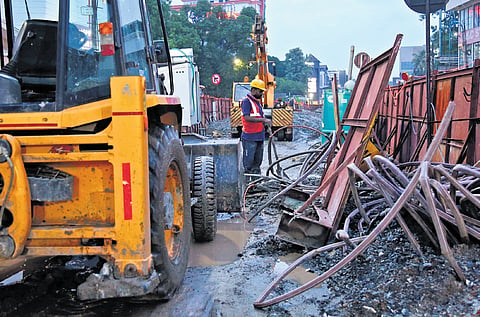

KOCHI: As Kochi Metro observes its eighth anniversary, the focus has now turned to the construction of the second phase, extending from Jawaharlal Nehru Stadium to Infopark via Kakkanad, which was awarded to Afcons Infrastructure in June 2024 with a tight 600-day construction deadline.
With the work suffering a delay, Kochi Metro Rail Ltd (KMRL) is now striving hard to meet the revised December 2026 deadline by carrying out the job even in the monsoon.
“We’ve resolved the hurdles, including those related to road widening and replacing overhead power lines with underground cables along the route. Now the construction activities have been hastened and we’re catching up with the revised deadline.
The work is progressing even amid the rain. A total of 552 piles have been constructed. Even today (on Thursday), the pile and pile cap concreting works were carried out,” said a senior KMRL official.
“The works of piles are progressing smoothly, that of pier caps have started and the construction of pillars will start soon,” said the official who added that the (work completion) figures don’t give the correct picture.
“We’re completing the ground-based works first. The superstructure components, including the pier cap, are precast segmental construction and the work on the same is progressing swiftly at the Casting Yard near HMT Kalamassery. Once that is over, the remaining work can be done quickly as we only need to take them to the site and fix them over the basic structures,” the official added.
While 28% of installation of piles (viaduct) has been completed, 1.5% of pile caps installation has been finished. Six per cent work of U-girders, 5% of pier caps and 1.2% of I-girders have also been finished.
“We’ve almost completed time-consuming activities like Geo Technical Investigation and Utility Investigation (55%). However, the percentage of completed work regarding pile caps is only 1.5% since they are fitted last,” the official pointed out.
Measures taken to ensure uninterrupted progress during monsoon
Securing construction materials, stabilising temporary structures and conducting inspections at all critical sites
Thorough cleaning of all choked drains, culverts, and water discharge paths along the alignment route
Dedicated Emergency Response Teams (ERTs) deployed at construction sites
Additional 10 traffic wardens deployed to ensure public safety and efficient traffic flow, bringing the total number of wardens to 30 across 30 critical locations